- This past week one rocket was fired at Israel from the Gaza Strip; it fell inside the Gaza Strip. In Judea and Samaria there were clashes between demonstrators and the IDF, particularly on Friday, May 1. Stabbing attacks were prevented in the Gush Etzion and Jerusalem regions.
- The Israeli security forces recently exposed a pipeline for channeling funds from Hamas in the Gaza Strip to Judea and Samaria via Jordan. Two Palestinian lawyers from the Hebron region were involved. The money was sent to strengthen the Hamas infrastructure in Judea and Samaria.
- Several senior Hamas figures recently called for rehabilitating Hamas' relations with Saudi Arabia. The Hamas political leadership apparently regards Saudi Arabian support as a means to save the faltering reconciliation agreement with Fatah and possibly as a means to improve relations with Egypt, a Saudi Arabian ally.
- Relations between Hamas and the Salafist-jihadi networks in the Gaza Strip are deteriorating. The Salafists claim Hamas detained 23 of their activists, and they threatened to harm Hamas activists if the detainees were not released. In the wake of the threat Hamas increased its security activities. The worsening in Hamas-Salafist relations may prompt Salafist-jihadists to attack Israel as a provocation to entangle Hamas in a clash with Israel.
Rocket Fire Attacking Israel
- On May 3, 2015, a rocket was fired from the Gaza Strip to attack Israel. It fell inside the Gaza Strip.
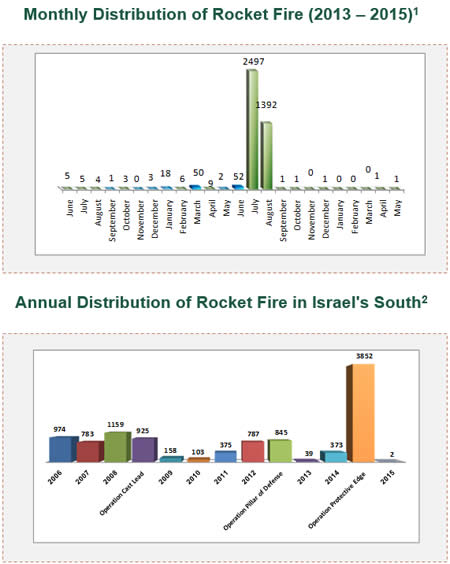
Demonstrations and Clashes
- This past week the wave of violence and rioting continued at the usual locations in Judea, Samaria and east Jerusalem, part of what the Palestinians call the "popular resistance." The violence mainly centered on throwing stones, rocks and Molotov cocktails. In some of the events which began on Friday, May 1, Palestinian demonstrators clashed with Israeli security forces.
- The Palestinian media reported extensively on dozens of Palestinians who inhaled tear gas used by the Israeli security forces during the dispersal of a demonstration on May 1, 2015. The Palestinian media also reported that two Palestinians from Kafr Qaddum, in the Qalqiliya district, claimed they had been wounded by live ammunition (Wafa.ps, May 1, 2015).
Stabbing Attacks Prevented
- On the morning of May 2, 2015, IDF forces prevented a stabbing attack at the Gush Etzion checkpoint in Jerusalem. A sixteen year-old Palestinian was one of the passengers on a bus stopped at the checkpoint. All the passengers got off the bus for inspection and an IDF soldier asked the Palestinian for identification. The Palestinian put his hand behind his back, took out a knife and tried to stab the soldier (IDF Spokesman, May 2, 2015).
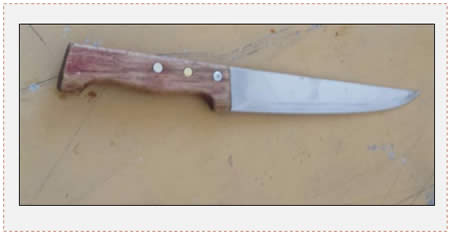
The knife found in the possession of the Palestinian who tried to stab an IDF soldier at the Gush Etzion checkpoint in Jerusalem (IDF Spokesman, May 2, 2015).
- In Jerusalem Hatem Saleh, 35, from east Jerusalem, tried to stab a light-railway security guard with a sharp object (according to another version, he attacked the security guard with a belt-buckle). He then proceeded towards a group of passengers while shouting "Allahu Akbar." One of the security guards present at the time shot him in the leg. He incurred a minor wound and was taken to a hospital (Police.gov.il, Ynetnews.co.il and Haaretz.co.il, May 4, 2015).
Smuggling of Improvised Submachine Gun Prevented[3]
- On May 2, 2015, IDF forces prevented an improvised Karl Gustav sub-machine gun from being smuggled into Israeli territory. At a checkpoint near Tulkarm a suspicious bag was discovered under the back seat during the routine inspection of a car carrying two male Israeli Arab passengers. The bag contained an improvised submachine gun. Note: Last year eight such weapons were found at the same location (IDF Spokesman, may 2, 2015).
Transfer of Terrorist Funds from the Gaza Strip to Judea and Samaria Prevented
- The Israeli security forces recently exposed a pipeline for channeling funds from Hamas in the Gaza Strip to Judea and Samaria via Jordan. Two Palestinian lawyers from the Hebron region were involved. Three Palestinian activists involved in the money transfers were detained:
- Ya'qoub Is'haq Abd al-Jawad Daa'is, born in 1990, a resident of Jordan, originally from Hebron.
- Yazan Abd al-Razaq Abd al-Mu'ti Shaour, born 1991, from Hebron. Palestinian lawyer with ties to Hamas activists.
- Yasser Muhammad Radwan Quqas, born 1972, from Beit Umar (north of Hebron). Hamas activist, Palestinian lawyer.
- The interrogation of the three revealed that they were supposed to establish a pipeline for channeling funds to finance terrorist activities. The funds were sent by senior Hamas activists in the Gaza Strip to Hamas activists in Judea and Samaria. The money was given to Ya'qoub Daa'is to deposit in Jordan, and from there he was to transfer it to Judea and Samaria where it would be given to a Palestinian lawyer in Hebron.
- One of the functions of the pipeline was to transfer funds for the legal representation of Hamas terrorist operatives. The investigation also revealed that the pipeline had been established to facilitate the transfer of large sums of money from Hamas in the Gaza Strip to Jordan and from Jordan to Hamas operatives in Hebron and Bethlehem.
- The funds were to be transferred secretly in a variety of ways. The money was to be used to strengthen the Hamas infrastructure in Judea and Samaria and to increase its activities. Thus the detention of the three prevented large amounts of money earmarked for terrorism from entering Judea and Samaria, thereby disrupting Hamas' operational activities in the region.
- In addition, the Israel Police Force reported that about a month ago a dentist from Kafr Canna (in northern Israel) was detained on suspicion of having transferred large sums of money to the Hamas infrastructure in Judea and Samaria. He had acted on instructions from a Hamas operative in the Gaza Strip. The dentist was indicted (Police.gov.il, May 5, 2015).
Rebuilding Hamas' Military-Terrorist Infrastructure
- According to Israeli security sources (quoted by Jacky Hugi, Haaretz.co.il, April 29, 2015), Hamas' military-terrorist wing is currently concentrating its efforts on rebuilding its military capabilities damaged during Operation Protective Edge. To that end new operatives are being recruited, the battalions seriously damaged in Operation Protective Edge are being reconstructed (especially in the Beit Hanoun, Shejaiya and Khan Yunis sectors) and new tunnels are being dug. The tunnels are being rebuilt "around the clock" by approximately 1,000 men. The raw materials necessary are mainly provided by private individuals who receive them to rebuild their own homes. Because of financial difficulties they are unable to complete the construction work and sell the materials on the black market. In addition, when possible, wood and rigid plastic are used instead of concrete slabs.
- It was also reported that in addition to rebuilding the tunnel system Hamas wants to improve the range of its rockets to 150 kilometers (about 93 miles). It is likely that Hamas is training engineers and other professionals to make it possible to manufacture the rockets in the Gaza Strip. That is because Egypt's strict policy in dealing with the tunnels in the Rafah region makes it difficult for Hamas to smuggle weapons into the Gaza Strip.
- According to the same security sources, Muhammad Deif, the commander of Hamas military-terrorist wing in the Gaza Strip, was not killed in the IDF's targeted strike against him in Operation Protective Edge. The sources claimed that within Hamas there are differences of opinion between the military-terrorist wing and the political leadership, which were evident even before Operation Protective Edge. The military-terrorist wing had a plan to use the tunnels to invade one of the Israeli villages near the Gaza Strip, apparently Kerem Shalom, and to abduct soldiers and civilians. The political leadership opposed the plan, to the great frustration of Muhammad Deif and his followers. During Operation Protective Edge Hamas tried to put the plan into action several times without success.
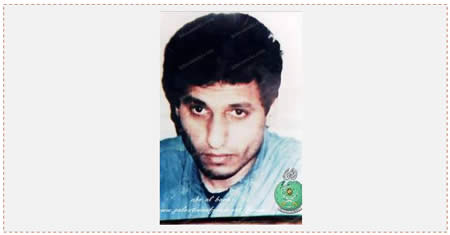
Muhammad Deif (Website affiliated with the Muslim Brotherhood)
- The security sources added that there were other disputes within the Hamas leadership regarding Hamas' finances, in particular regarding its ties with Iran. The military-terrorist wing advocates a rapprochement with Iran (with which relations have worsened in recent years) while the political leadership, especially the external leadership headed by Khaled Mashaal, wants a rapprochement with Saudi Arabia (See below). Khaled Mashaal is of the opinion that a rapprochement with Saudi Arabia will open the door for Hamas to the Arab world and aid the movement in overcoming its difficulties with Egypt (with which relations have deteriorated). The military-terrorist leadership, on the other hand, is of the opinion that only Iran can provide Hamas with substantial support.
Praise for Saudi Arabia from Senior Hamas Figures and a Call for Its Deeper Involvement in the Palestinian Arena
- Senior Hamas figures recently called for an improvement in relations with Saudi Arabia:
- Ismail Haniya, deputy head of Hamas' political bureau, praised Saudi Arabia and its support of the Muslim nation in general and the Palestinian people in particular. In a Friday sermon given in the Saudi neighborhood in Rafah, and which was – exceptionally – broadcast live on Saudi Arabian TV, he stressed the importance of the Saudi support for the internal Palestinian reconciliation. He also called on Saudi Arabia to support Hamas both militarily and politically, and to increase its involvement in promoting the internal Palestinian reconciliation (Alaqsavoice.ps, May 1, 2015)
- Mahmoud al-Zahar, a member of Hamas' political bureau, called on Saudi Arabia to act in conjunction with Fatah and Hamas to formulate a new version of the Saudi Arabian-sponsored Mecca Agreement [i.e., the "Mecca 2 Agreement"] (Alresala.net, May 2, 2015).
- Ali Barakeh, Hamas representative in Lebanon, also called for an improvement in relations with Saudi Arabia. He claimed that contacts had been held between the Hamas leadership and Saudi Arabia. He also claimed that relations were going in the right direction, as would be shown by a visit of the Hamas leadership to Saudi Arabia (Sawa.ps, May 2, 2015).
- Such statements by senior Hamas figures probably indicate that Hamas' political leadership wants to improve relations with Saudi Arabia even at the expense of its relations with Iran, a Saudi Arabian rival (Saudi Arabia leads the campaign against Iran's attempt to influence the Arab world). Apparently, Saudi Arabian support is perceived by Hamas' political leadership as a means to save the faltering reconciliation between Hamas and Fatah and the Palestinian Authority (PA), and possibly also as a way of improving relations with Egypt, a Saudi Arabian ally.
Hamas Uses Force to Disperse a Rally in Support of Ending the Internal Palestinian Rift
- On April 29, 2015, local activists in the Gaza Strip from the network called "the April 29 campaign" demonstrated to end the internal Palestinian rift. They called on Mahmoud Abbas and Hamas to act immediately. Hamas security forces wearing civilian clothes used force to disperse the rally (Maannews.net, Facebook page of Fatah, April 29, 2015).
Israeli Navy Returns Fishing Boats to the Gaza Strip
- On April 29, 2015, the Israeli Navy returned 15 fishing boats which had been seized in recent years for going beyond the fishing limits set for the Gaza Strip. Returning the boats was another in a series of civilian measures taken by the Israeli Coordinator for Government Activities in the Territories, acting on instructions from the political leadership (IDF Spokesman, April 29, 2015).
Military Training for Youths
- On May 1, 2015, graduation exercises were held in the Bureij refugee camp for a military training course. The course participants were Gazan youths who had joined the so-called "Pioneers of Liberation"[3] project. Senior Hamas figure Musa al-Samar gave a speech calling on Gazan youth to "grasp their weapons" and adhere to the "the path of jihad and resistance" [i.e., terrorism] (Qassam.ps, May 2, 2015; Paltimes.net, May 1, 2015).
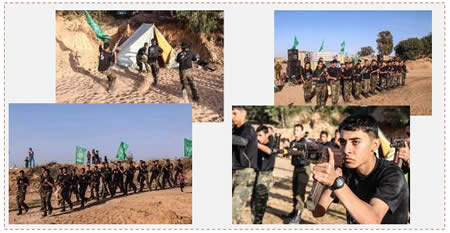
Pictures from the graduation exercises of the military training course of the "Pioneers of Liberation" (Facebook page of the "Pioneers of Liberation" camps, May 2, 2015)
Relations between Hamas and Salafist-Jihadist Operatives Deteriorate
- Relations between Hamas and the Salafist-jihadi networks in the Gaza Strip have recently deteriorated. The reason is unclear, however it is possible Hamas suspects the networks of being involved in subversive activities. It is also possible that Hamas suspects ISIS of being behind the jihadi networks' subversion. In any event, the deterioration of relations and the threats of the Salafists against Hamas (See below) are not only an internal issue.Rather, they may result in a provocative terrorist attack against Israel, carried out by jihadist operatives in the Gaza Strip to entangle Hamas in a clash with Israel.
- A senior Salafist activist in the Gaza Strip claimed that Hamas' security forces had detained 23 Salafist activists, and that the security forces were looking for 25 other activists accused of supporting ISIS. He claimed the detainees were being tortured in one of the security force prisons in Gaza (Al-ayyam.com, May 1, 2015). Abu al-Ainaa' al-Ansari, a senior Salafist activist in the Gaza Strip, claimed the Hamas security forces had detained seven Salafist activists in one of the mosques in Dir al-Balah during the Friday prayer, and that one of them was Sheikh Yasser Abu Houli, a prominent Salafist-jihadi activist in Gaza (Alqudsnews.net, May 1, 2015).
- In response to the detentions, on April 29 and May 3, 2015, a Salafist-jihadi network posted two notices with a threat to Hamas. The network calls itself the "Supporters of the Islamic State in Bayt al-Maqdis (i.e., greater Jerusalem, or Palestine), possibly an indication of affiliation with ISIS (supported by the fact that the ISIS logo appears on the threats). The April 29 posting called on Salafist activists in the Gaza Strip to show solidarity in the face of Hamas' detentions of their comrades. The May 3 posting warned that if Hamas continued persecuting the Salafists in the Gaza Strip and did not release the detainees within 72 hours, the network would attack Hamas targets. A report from a Fatah media source claimed that the Salafists threatened to personally attack Hamas activists involved in the activity against them. They made public a number of names, addresses and pictures of Hamas internal security force operatives (Sawt Fatah, May 4, 2015).
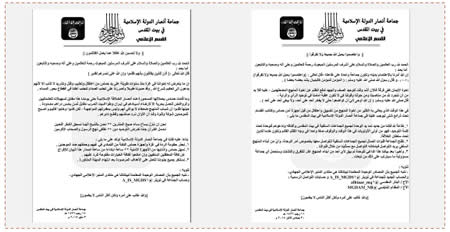
Left: The May 3 posting (Twitter account affiliated with ISIS, May 3, 2015). Right: The April 29 posting (Twitter account affiliated with ISIS, April 29, 2015). The ISIS logo is in the upper left hand corner.
- According to a report from the Gaza Strip, Hamas increased its security activity against the Salafist activists in the central Gaza Strip. That included erecting roadblocks and inspecting every passing vehicle (Al-ayyam.com, May 4, 2015).
Reconstructing the Gaza Strip
- The Arab authority for reconstructing the Gaza Strip signed an agreement for collaboration with the Islamic Development Bank in Jeddah and with the Sultanate of Oman for the rebuilding and new construction of 50 dwelling units for needy families in the Gaza Strip. The cost is estimated at $1 million. During the first stage, 13 houses will be rebuilt within one month (Facebook page of PALDF, May 3, 2015).
- In the meantime demonstrations continue in the Gaza Strip, in ITIC assessment encouraged mainly by Hamas, to protest the delays in reconstruction. On May 4, 2015 there Palestinian activists held a demonstration in the eastern Gaza Strip near the border. They waved Palestinian flags and burned tires (Paltoday.tv, May 4, 2015).
Preparations for the Freedom Fleet 3 Flotilla to the Gaza Strip
- Zaher Birawi, coordinator for the so-called International Committee to Break the Siege of the Gaza Strip, recently claimed that at least three ships would sail towards the Gaza Strip this summer, part of the so-called Freedom Fleet 3 flotilla. He claimed the ships were now seaworthy. The activists dispatching the flotilla were supposed to meet in Greece between May 16 and 17, 2015, to discuss the final details, logistics and procedures. He also said that an announcement regarding the time and place for the sailing would not be issued at this time, to keep Israel from being able to exert pressure on the countries from which the ships would sail (Felesteen.ps, April 30, 2015).
- Zaher Khaled Hassan Birawi (Abu Khaled) is a Palestinian from the village of Asira al-Shimaliyah, north of Nablus. He has lived in Britain since the 1990s where he has been active in various anti-Israeli organizations and bodies. Although a Hamas activist, he is careful not to identify himself as such. In the past he was extensively and continuously involved in sending convoys to the Gaza Strip (the so-called "Life Line" convoys) for Viva Palestina, the organization headed by anti-Israeli MP George Galloway. Zaher Birawi was also involved in dispatching the Mavi Marmara (May 2010).
[1] As of May 5, 2015. The statistics do not include mortar shell fire or rockets which misfired and fell inside the Gaza Strip.
[2] The statistics do not include mortar shell fire.
[3] Website of the Israel Security Agency, April 28, 2015.
[4]"Pioneers of Liberation" is a Hamas youth project instituted in June 2014. An estimated one hundred thousand Gazan children and youths participate and it is held in a number of refugee camps throughout the Gaza Strip. In the camps participants undergo semi-military training in schools and mosques. For further information see the July 7, 2014 bulletin "This year, as in years past, summer camps in the Gaza Strip were exploited by Hamas for radical Islamic ideological indoctrination and semi-military training."













